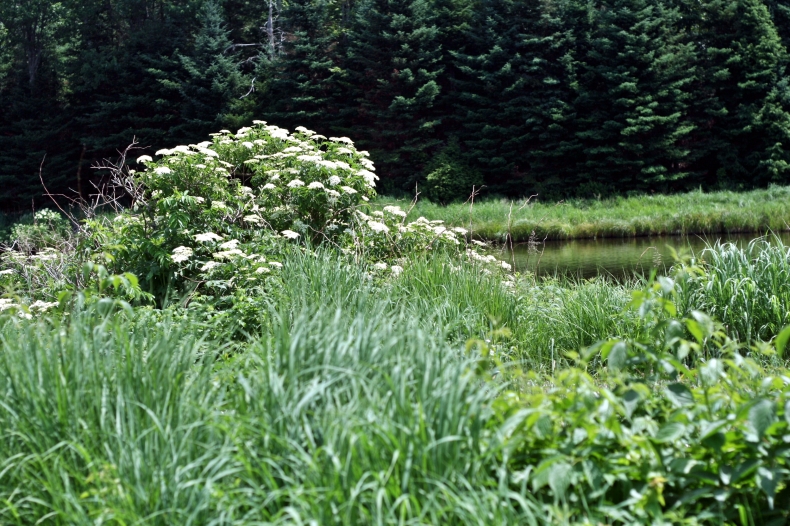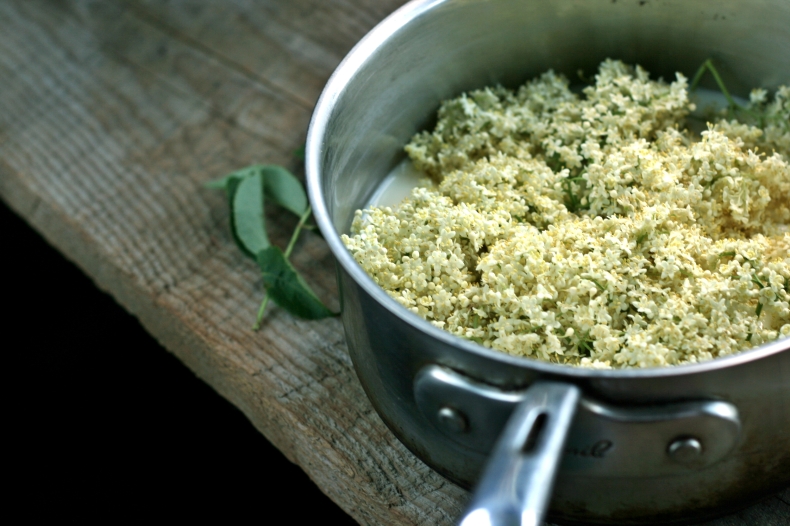
As June dissolves away into the first humid and hot days of July, the elder flowers start to bloom. They are everywhere. Along every roadside, looking up from every moist ditch, surrounding the borders of every pond and every lake. Everywhere. Cloud like sprays of cream-colored blossoms ablaze in the strong summer sunshine, filling the still sticky air with the breath of their sweet honeyed perfume. A smell that is of summertime. A smell that is magical.


The elder flowers are a sign to me, one of those subtle markers that signify a certain time of year, that mark out the sensations that belong only to one small stretch of time in the calendar. Now the elders are blooming I think to myself, it is that time of year. It seems more revealing, more elucidating, somehow, than saying it is the first week of July.
Up close, they are like sprays of tiny, delicate stars woven together as fine as any lace. They make one think of moonlight. There are stories, legends, that if you were to fall asleep in the shade of an elder, you would dream of fairies and elves and magical things – and if you happened to sit under the elder on the eve of midsummer’s night, you might see the fairy king march by himself.

It is easy to believe these stories, when you are filling your basket with those lacy blooms on a hot summers day, your fingers dusted with golden pollen, breathing in their sweetness. You really feel you might get whisked away to another world.

We picked for sometime, this past weekend, my friend Shari and I. We picked until our baskets were full and our legs and arms scratched up by the brambles that surround the elders. Then we walked out into the little lake that they grow by, splashing ourselves with water and watching the sunlight glinting off the lake’s rippled surface. It was such a lovely day.
I brought my harvest home and set about thinking what I might do with it. Some I set aside to dry for tea, which I like to put in cold and flu blends for the winter time. Some I mixed into a little jar with sugar, for making elder scented cakes. Some I packed into a tall jar full of water, to gently infuse overnight in the fridge, for drinking cold on these hot days (an idea I got from Lucinda).

And some I used to make these delicately flavored Pots de Crème – little jars of baked custard that I topped with rhubarb compote. The result was just what I was hoping for – light, creamy, delicately perfumed with the scent of the flowers and just sweet enough to oppose the tart rhubarb. A perfect desert for this very time of year. The elderflower time.


Elderflower pots de crème with rhubarb compote
Feel free to sub in other fruits as well – gooseberry would be a good traditional pairing but strawberry or raspberry would also be divine as well. Custard recipe adapted from La Tartine Gourmande by Beatrice Peltre. Serves 4.
For the compote:
- 1 lbs rhubarb, chopped into 1/2 inch pieces
- 3/4 cup unrefined cane sugar
- juice of 1/2 a lemon
- 2 tablespoons of elderflower cordial or liqueur (optional)
For the custard:
- 2 1/3 cups whole milk
- 4 medium-sized heads of fresh elder-flower blossoms
- 1 vanilla bean, split open and seeds scraped out
- 1 egg plus 4 egg yolks
- 1/4 cup unrefined cane sugar
To make the compote, combine the sugar with a tablespoonful or two of water along with the elderflower cordial or liqueur (if using) and bring to a boil over high heat, stirring until the sugar is dissolved. Add the rhubarb, letting the mixture come back to a full boil before reducing to a gentle simmer. Continue to cook until the rhubarb has just begun to break down, but still has some texture (about 20 minutes) and remove from heat before stirring in the lemon juice. Place in the fridge and chill completely.
To make the custard, preheat the oven to 320 degrees F. Place the milk into a saucepan and heat until just beginning to bubble, the remove from heat. Add the elder-flowers and vanilla and cover the pot, leaving to infuse for at least 30 minutes.
When the milk has finished infusing, pour the mixture through a sieve or finely meshed strainer to separate out the flowers and vanilla pod. Check the temperature and be sure it is still warm the touch – if not, reheat gently.
Meanwhile, beat the eggs and egg yolks with the sugar in a medium-sized bowl. When the milk is ready, slowly pour it into the eggs, stirring all the time. Once it is well incorporated, pour the mixture into 4 cup-sized mason jars, filling them about 2/3 of the way full.
Place the jars into a casserole dish or cake tin large enough to hold them without touching, and fill the pan with boiling water so that it comes about 1/2 way up the sides of the jars. Place the pan into the oven and bake for 45-50 minutes, until the custards are set and the middle only jiggles slightly when you move them.
Let cool to room temperature and then place a small piece of plastic wrap or parchment paper on the top of each custard to prevent a film forming and chill them in the fridge for several hours.
When ready to serve, top each custard with a spoonful of the rhubarb compote and a scattering of fresh individual elder flowers.
PS For more elder love, you can read this post or head over to Whispering Earth for this lovely post














